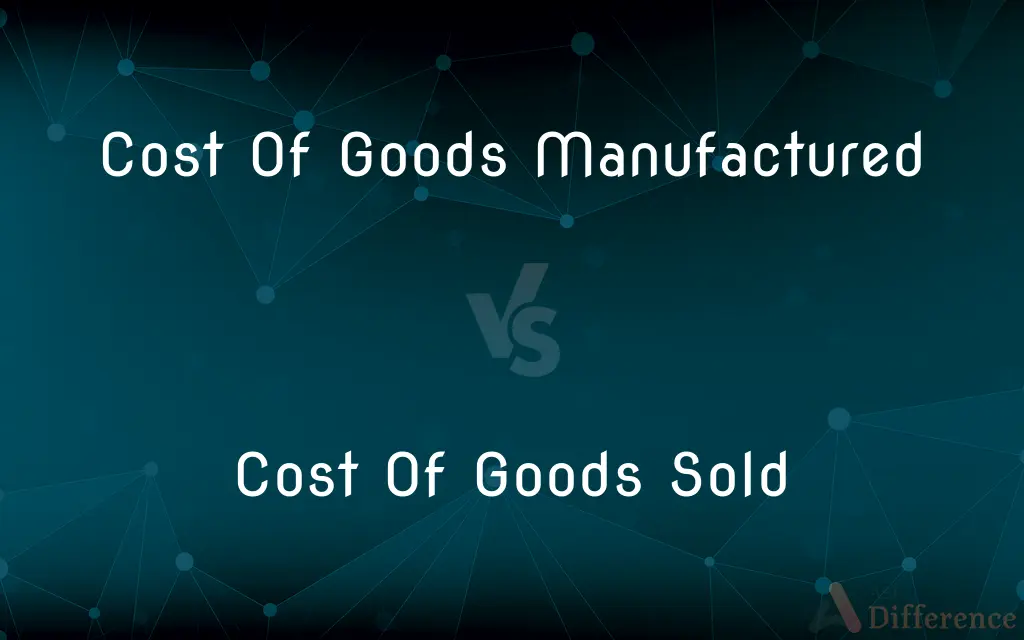Cost Of Goods Manufactured vs. Cost Of Goods Sold — What's the Difference?
By Tayyaba Rehman — Published on October 14, 2023
Cost of Goods Manufactured (COGM) is the total cost incurred to manufacture products, while Cost of Goods Sold (COGS) is the total cost of products sold during a specific period.

Difference Between Cost Of Goods Manufactured and Cost Of Goods Sold
Table of Contents
ADVERTISEMENT
Key Differences
Cost of Goods Manufactured and Cost of Goods Sold are critical financial concepts, but they represent different aspects of production and sales costs. Cost of Goods Manufactured encompasses the total costs incurred to manufacture products, including raw materials, labor, and overhead costs. It gives a comprehensive view of the production expenses incurred by a company to produce goods within a specific period. This measure is vital for manufacturing companies as it reflects the direct costs associated with producing items ready for sale.
In contrast, Cost of Goods Sold represents the total cost of goods that have been sold to customers during a specific period, including the costs of producing or purchasing the goods. This cost is deducted from the company's revenue to determine the gross profit. It is crucial for businesses to monitor and manage COGS efficiently as it directly impacts profitability.
While Cost of Goods Manufactured focuses exclusively on the costs incurred during the production process, Cost of Goods Sold extends to encompass the cost of goods that have been sold, impacting the company's income statement directly. COGM is especially relevant to manufacturing entities, allowing them to gauge production efficiency and manage production costs effectively.
COGS, on the other hand, is applicable to all businesses dealing in goods, whether they manufacture them or purchase them for resale. It plays a significant role in pricing strategies and profit margin analysis, enabling companies to set competitive prices while maintaining healthy profit margins.
In summary, Cost of Goods Manufactured is concentrated on production costs, providing insights into manufacturing efficiency and cost management, while Cost of Goods Sold is broader, representing the cost of goods that are sold, affecting gross profit and overall profitability.
ADVERTISEMENT
Comparison Chart
Focus
Total cost incurred to manufacture goods
Total cost of goods that have been sold
Usage
Manufacturing companies
All businesses dealing in goods
Impact on Financial Statement
Used to calculate COGS
Directly affects the income statement
Relevance
Manufacturing efficiency and cost management
Pricing strategies and profit margins
Includes
Raw materials, labor, and overhead costs
COGM plus beginning inventory less ending inventory
Compare with Definitions
Cost Of Goods Manufactured
It includes direct materials, direct labor, and manufacturing overhead.
The inclusion of labor and overhead costs significantly increased the Cost of Goods Manufactured for the quarter.
Cost Of Goods Sold
Includes the Cost of Goods Manufactured plus beginning inventory minus ending inventory.
The finance team accurately calculated the Cost of Goods Sold, considering the beginning and ending inventory levels.
Cost Of Goods Manufactured
Helps in determining the Cost of Goods Sold in the income statement.
A precise calculation of Cost of Goods Manufactured is vital for the accurate representation of COGS in financial statements.
Cost Of Goods Sold
Is relevant for all businesses dealing in goods, whether manufacturing or reselling.
Regardless of the nature of the business, optimizing the Cost of Goods Sold is imperative for maintaining profitability.
Cost Of Goods Manufactured
A crucial measure for manufacturing companies to assess production efficiency.
The elevated Cost of Goods Manufactured prompted the company to reassess its production processes.
Cost Of Goods Sold
Represents the total cost of goods that have been sold during a specific period.
The company’s Cost of Goods Sold was notably high, affecting the overall profitability.
Cost Of Goods Manufactured
Represents the costs exclusively related to the manufacturing process.
The finance department meticulously calculated the Cost of Goods Manufactured to ensure accurate reporting.
Cost Of Goods Sold
Directly affects a company's gross profit on the income statement.
By reducing the Cost of Goods Sold, XYZ Inc. was able to report higher gross profits this quarter.
Cost Of Goods Manufactured
The total cost incurred to produce goods ready for sale.
The Cost of Goods Manufactured for ABC Corp. was $200,000 for the month of January.
Cost Of Goods Sold
Is crucial for determining pricing strategies and analyzing profit margins.
Adjustments in pricing were made after a thorough analysis of the Cost of Goods Sold.
Common Curiosities
What is included in Cost of Goods Sold?
Cost of Goods Sold includes the Cost of Goods Manufactured, plus beginning inventory, minus ending inventory.
Does Cost of Goods Manufactured include raw materials, labor, and overhead costs?
Yes, Cost of Goods Manufactured includes raw materials, direct labor, and manufacturing overhead costs.
Does Cost of Goods Sold impact gross profit?
Yes, Cost of Goods Sold directly impacts a company's gross profit.
What does Cost of Goods Manufactured represent?
Cost of Goods Manufactured represents the total cost incurred to manufacture products.
Is Cost of Goods Manufactured only relevant to manufacturing companies?
Yes, Cost of Goods Manufactured is primarily relevant to manufacturing companies.
Is Cost of Goods Manufactured used to calculate Cost of Goods Sold?
Yes, Cost of Goods Manufactured is used as a component in calculating Cost of Goods Sold.
Does Cost of Goods Sold include only the cost of goods that have been sold?
Yes, Cost of Goods Sold represents the total cost of goods that have been sold during a specific period.
Can the high Cost of Goods Manufactured affect the company’s competitiveness?
Yes, a high Cost of Goods Manufactured can negatively impact competitiveness by necessitating higher product prices.
Is Cost of Goods Sold crucial for pricing strategies?
Yes, analyzing Cost of Goods Sold is crucial for developing effective pricing strategies.
Can Cost of Goods Manufactured provide insights into manufacturing efficiency?
Yes, Cost of Goods Manufactured can offer valuable insights into manufacturing efficiency and cost management.
Can managing Cost of Goods Sold effectively increase profitability?
Yes, effectively managing Cost of Goods Sold can significantly enhance a company’s profitability.
Can Cost of Goods Sold be minimized by optimizing inventory levels?
Yes, optimizing inventory levels can help in minimizing the Cost of Goods Sold.
Share Your Discovery

Previous Comparison
Static Friction vs. Kinetic Friction
Next Comparison
Cooperative Banks vs. Public Sector BanksAuthor Spotlight
Written by
Tayyaba RehmanTayyaba Rehman is a distinguished writer, currently serving as a primary contributor to askdifference.com. As a researcher in semantics and etymology, Tayyaba's passion for the complexity of languages and their distinctions has found a perfect home on the platform. Tayyaba delves into the intricacies of language, distinguishing between commonly confused words and phrases, thereby providing clarity for readers worldwide.
















































